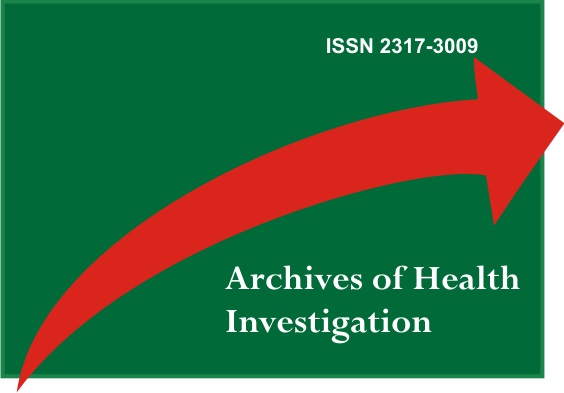Knowledge of Brazilian Dentists in the Detection of Child Abuse
DOI:
https://doi.org/10.21270/archi.v12i2.5887Keywords:
Child Abuse, Forensic Dentistry, KnowledgeAbstract
Objectives: The objective of the present study was evaluate the knowledge of dentist surgeons to detect child abuse as well signs and symptoms, and the correct identification of the agency to forward the notifications of cases. Methods: Forms was sent by e-mail and social media (Whatsapp, Instagram, etc.) with objective questions to dentist surgeon from Northeast in Brazil, where it got 99 forms corrected answered. Data were analyzed using Fisher's Exact and Chi-square tests to identify associations between the variables studied. Results: The results identified that 55.6% of the professionals considering themselves able to diagnose possible child abuse cases. Tied to this fact, the results shows that 55.6% of dentist surgeons receive orientation about the topic “Child abuse” along the graduation, where they identified mostly the courses Pedriatric dentistry, Legal dentistry and Public health as the main spreader of this topic. Moreover, the Guardianship Council was identified by 82.8% of professionals as the appropriated place to make notification of child abuse cases. Among the professional 65.7% of dentist surgeons recognize signs and symptoms of possible child abuse in children and teenagers. Conclusion: In conclusion, the majority of dentist surgeons have adequate knowledge about child abuse as well the law and agency that rule notifications of these cases, but they do not have knowledge about notification form necessary for the complaints.
Downloads
References
Who. Version of the Introduction to the World Report on Violence and Health: WHO. Geneva: 2002.
Rosa ACMÁ, Miasato JM, Andrade DT, Oliveira LMC, Silva LAH, Tesch FC. A conduta do cirurgião-dentista frente aos maus-tratos infantis: uma revisão de literatura. Rev UNINGÁ. 2021;58:1–10.
Teodoro CC. Criança e adolescente: da invisibilidade social e naturalização da violência à perspectiva da proteção integral. Rev Humanid Inov. 2020; 2:148–62.
Carvalho C. Diagnóstico: abuso infantil. RBO. 2002:180–83.
Alves PM, Cavacanti AL. Diagnóstico do abuso infantil no ambiente odontológico: uma revisão da literatura. Cienc Biol Saúde. 2003; 9:29–35.
Weber LND. et al. Famílias que maltratam: uma tentativa de socialização pela violência. Psico-USF. 2002; 7:163–173.
Massoni ACLT, Ferreira AMB, Aragão AKR, Menezes VA, Colares V. Orofacial aspects of childhood abuse and dental negligence. Cien Saude Colet. 2010;15:403–10.
Rover ALP. et al. Violência contra a criança: indicadores clínicos na odontologia. BJD. 2020; 6:43738–750.
Silveira JLGC, Mayrink S, Sousa OB. Maus-tratos na infância e adolescência: casuística, conhecimento e prática de cirurgiões-dentistas de Blumenau-SC. Pesq Bras Odontopediatria Clín Integr. 2005; 5:119–126.
Cavalcanti AL, Duarte RC. Manifestações Bucais do Abuso Infantil em João Pessoa-Paraíba-Brasil. Rev Bras Ciênc Saúde. 2003:161–70.
ECA. Lei no 8.069, de 13 de julho de 1990 - Estatuto da Criança e do Adolescente Dispõe sobre o Estatuto da Criança e do Adolescente e dá outras providências. Brasília: Diário Oficial da União; 1990. [Acesso em: 01 de dezembro de 2021]. Disponível em: http://www.planalto.gov.br/ccivil_03/leis/l8069.htm
Conselho Federal de Odontologia. Código de ética odontológica. In: Código de ética odontológica. 1998:20.
Burns EE, Jackson JL, Harding HG. Child Maltreatment, Emotion Regulation, and Posttraumatic Stress: The Impact of Emotional Abuse. J .Aggression, Maltreatment & Trauma. 2010;19:801-19.
Voestermans D. et al. The Association Between Childhood Trauma and Attachment Functioning in Patients With Personality Disorders. J. Pers. Disord. 2021;35:554-572.
Costa AP, Tinoco RLR. Maus-tratos infantis no currículo dos cursos de Odontologia do Rio de Janeiro. Rev ABENO. 2019;19:54–62.
Leonardi LA. et al. Conhecimento e percepção dos acadêmicos de Odontologia do Paraná sobre maus-tratos infantis. Rev ABENO. 2021;21:1254.
Sousa GFP. et al. Conhecimento de acadêmicos em odontologia sobre maus-tratos infantis. Odonto. 2012;20:101–8.
NILCHIAN, F.; TARRAHI, M. J.; ZARE, N. A systematic review and meta-analysis of failure to take history as a barrier of reporting child abuse by dentists in private and state clinics. Dent Res J. 2021;18(1):41.
ECA. Lei no 13.010, de 26 de junho de 2014 - Estatuto da Criança e do Adolescente Dispõe sobre o Estatuto da Criança e do Adolescente e dá outras providências. Brasília: Diário Oficial da União; 2014. [Acesso em: 01 de dezembro de 2021]. Disponível em: https://www.planalto.gov.br/ccivil_03/_ato2011-2014/2014/lei/l13010.htm
Sociedade Brasileira de Pediatria – SBP. 233 Casos de violência física e psicológica contra crianças e adolescentes são notificados todos os dias. Rio de Janeiro, 16 de jun de 2019. [Acesso em: 03 de jun de 2021]. Disponível em: https://www.sbp.com.br/imprensa/detalhe/nid/233-casos-de-violencia-fisica-ou-psicologica-contra-criancas-e-adolescentes-sao-notificados-todos-os-dias/
Dalledone M, Paola APBD, Correr GM, Pizzatto E, Souza JFD, Losso EM. Child abuse: perception and knowledge by Public Health Dentistry teams in Brazil. Brazilian J Oral Sci. 2015;14:224-29.
Granville-Garcia AF, Silva MJF, Menezes VA. Maus-Tratos a Crianças e Adolescentes: Um Estudo em São Bento do Una, PE, Brasil. Pesqui Bras Odontopediatria Clin Integr. 2008;8:301–7.
Silva AM, Santos J, Almeida LH. Conhecimento do cirurgião-dentista acerca de maus-tratos à criança e ao adolescente. Revista da Faculdade de Odontologia –UPF. 2019;24:250-55.
Granville-Garcia AF, Vieira ÍTA, Siqueira MJPS, Menezes VA, Cavalcanti AL. Traumatic dental injuries and associated factors among Brazilian preschool children aged 1-5 years. Acta odontol. latinoam. 2010;23:47–52.
Neto IM, Matos FZ, Borges ÁH, Rezende CD, Silva KL, Pedro FLM, Porto AN. Avaliação do conhecimento dos alunos de graduação em odontologia x cirurgião dentista no diagnóstico de maus-tratos a crianças. ROBRAC. 2013;22:153–57.
Oshima AMMY, Besegato JF, Lima CV, Santos Noronha M, Hoeppner MG, Caldarelli PG. Perfil, atuação e satisfação de cirurgiões-dentistas em Residências Multiprofissionais em Saúde da região Sul do Brasil. Rev ABENO. 2018;18:134-45.
Busato CDA, Pereira TCR, Guaré RO. Maus-tratos infantis na perspectiva de acadêmicos de Odontologia. Rev ABENO. 2018;18:84–92.


